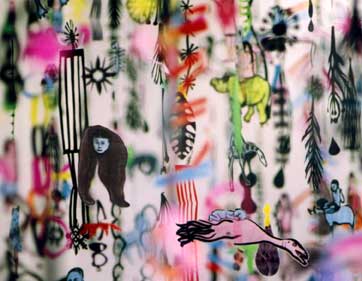How to forget
Forest
City Gallery, London, Ontario Nov. 21 - Dec. 20, 2003
http://www.forestcitygallery.ca/

Implicit in Darwin's theory of evolution - it's other side - is "forgetfulness and the vanishing of matter." This exhibition polarizes two views of the future : first, extinction and the creation of "the age of loneliness, an impoverished world of our own making". The other is continued evolution and a world that complicates itself ceaselessly, wonderfully and dangerously.
The gallery is divided into 2 parts separated by a translucent curtain. On the bright side are a series of motorized revolving structures with cascading strands of hundreds of images. They are back lit and projected on the scrim. The dark side is empty except for shadows that glide along the curtain.
The case for extinction grows from the insubstantial, from partial glimpses, from simulacra which have their own dark seductiveness. They are the first thing the viewer sees.
Curiosity will, I hope, take the viewer to the other side of the curtain. There, suddenly, the vast extent of other possibilities (to come or which have been) become visible.
The argument for evolution consists of a restless profusion of strange shapes and figures, a world without species barriers, linked incongruities. Stylistically naive, this "brave new world" recalls childhood - our private, personal utopian moment. It is an escape from a corrupt adult world, a recommitment to optimism, play and invention.
Where we are headed depends on where we think we are now - on the viewers' own psychological inclinations and on where they position themselves in time in relation to the piece. All that separates the two is the membrane thin divide of the scrim.